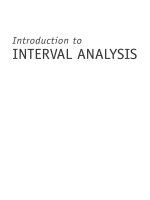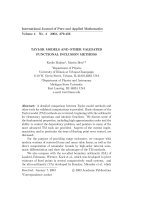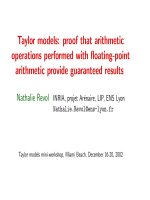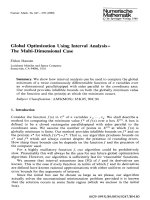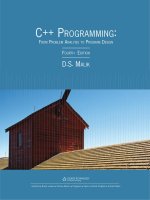From interval analysis to taylor models an overview lohner
Bạn đang xem bản rút gọn của tài liệu. Xem và tải ngay bản đầy đủ của tài liệu tại đây (136.16 KB, 8 trang )
From Interval Analysis to Taylor Models - An Overview
Markus Neher
Universit¨at Karlsruhe, Institut f¨ur Angewandte Mathematik
76128 Karlsruhe, Germany
Abstract
Interval arithmetic has been widely used in enclosure methods for almost 40 years. Today,
it is a well established tool for the calculation of rigorous error bounds for many problems
in numerical analysis.
Despite its overall success, interval arithmetic suffers from two drawbacks: the dep e n-
dency problem and the so-called wrapping effect, which both may overestimate the true
error of some computation.
To reduce overestimation, Taylor models have been developed as a symbiosis of a com-
puter algebra method and interval arithmetic by M. Berz and his group since the 1990s.
Software implementations of Taylor models have been applied to a variety of problems, such
as global optimization problems, validated multidimensional integration, or the solution of
ODEs and DAEs.
The validated solution of ODEs is used for exemplifying the distinction of interval meth-
ods and Taylor model methods.
1 Interval Computations
Interval arithmetic attracted wide attention with the publication of the pioneering work of R.
E. Moore [24] in 1966. In his book, not only the foundation of interval arithmetic has been
laid; it also contains interval methods for various fundamental problems, such as a discussion of
inclusion functions for the computation of range bounds for real functions, an interval version
of Newton’s method, a chapter on automatic differentiation, and algorithms for the validated
solution of ODEs. Extensive introductions to interval computations have also been given in the
monographs [1, 11, 28].
Real interval arithmetic is based on closed bounded intervals. Arithmetic op e rations between
two intervals X = [x, x] and Y = [y, y] are defined in such a way, that the result contains all
values that are obtainable by relating the real numbers in X and Y . For example, the sum of
two intervals is defined as
[x, x] + [y, y] := [x + y, x + y ].
Interval operations b etween interval vectors and interval matrices are constructed by applying
scalar interval arithmetic componentwise. Interval functions are defined in the same manner.
Interval evaluation of a rational expression r(x) for some interval X means inserting X for x
and evaluating according to the rules of interval arithmetic. Other real functions are extended
via range enclosures. For example, the interval exponential function is given by
e
X
:= [e
x
, e
x
].
1
Interval enclosures of solutions to continuous problems, such as integral equations, ODEs or
PDEs, are defined in a similar way.
Interest in interval arithmetic has been primarily aroused by the limitations of the floating
point number format used on digital computers. In floating point arithmetic, real numbers are
approximated by a finite screen of machine representable numbers. Whenever a real number
x that is not exactly representable is stored on a computer, or when intermediate results of a
calculation are approximated by machine numbers, roundoff errors occur. It was early observed
(e.g., see [9]) how these errors may accumulate until the computed result is no longer meaningful.
Interval arithmetic provides a tool for controlling roundoff errors automatically. Instead
of approximating x by a machine number, the real value x is enclosed into a real interval
X = [x, x] with machine representable bounds x ≤ x. In all subsequent calculations, x is
replaced by X. The operations between real numbers are then replaced by the respective
interval operations. For restoring mathematical rigor in a floating point number system, the
rules of interval arithmetic are extended by directed rounding operations, such that the exact
result of any arithmetic operation is automatically enclosed in a floating-point interval, including
roundoff errors. For example, sum and difference of two floating point intervals
X + Y := [x
+
y, x
+
y] ⊇ {x + y | x ∈ X, y ∈ Y },
X − Y := [x
−
y, x
−
y] ⊇ {x −y | x ∈ X, y ∈ Y }
are each calculated with two basic arithmetic operations between the endpoints of the intervals
X and Y , where
, denote operations with downward or upward rounding, respectively.
Definitions of validated computer arithmetic have been given in [15, 16].
Interval analysis is also used for bounding all kinds of truncation errors: the truncation
error of an infinite iteration, as in the interval version of Newton’s method [24, Chap. 7], the
remainder term of a convergent series [27], discretization errors in the numerical solution of
differential equations [24, Chap. 10], etc.
2 Dependency Problem and Wrapping Effect
Interval arithmetic is sometimes affected by overestimation, such that computed error bounds
are over-pessimistic. Overestimation is often caused by the dependency problem, which is the
lack of interval arithmetic to identify different occurrences of the same variable. For example,
x −x = 0 holds for each x ∈ [1, 2], but X −X for X = [1, 2] yields [−1, 1]. A second source of
overestimation is the wrapping effect, which appears when intermediate results of a computation
are enclosed into intervals. The wrapping effec t was first observed by Moore in 1965 [23]; a
recent analysis has been given by Lohner [18].
Example 1. Wrapping effect.
Consider the function
f : (x, y) →
√
2
2
(x + y, y − x).
The image of the square [0,
√
2]
2
is the rotated square with corners (0, 0), (1, −1), (2, 0), (1, 1).
On the other hand, interval computation yields
f([0,
√
2], [0,
√
2]) = ([0, 2], [−1, 1]).
2
Note that the observed overestimation (the area of the interval enclosure is twice the area of
the range) is not a result of dependency, but of the enclosure of a non-interval shaped range
into an interval. Overestimations of this kind are one of the major problems in the interval
arithmetic treatment of ODEs.
3 Taylor Models
For reducing both the dependency problem and the wrapping effect, interval arithmetic has
been endorsed with symbolic extensions. Symbolic-numeric computations have been proposed
under various names since the 1980s [7, 13, 20]. Early implementations in software were also
given [7, 12], but to the author’s knowledge, these packages have not been widely distributed
and are not available today.
A rigorous multivariate Taylor arithmetic has been developed by Berz and his group since
the 1990s [2, 20]. A Taylor model of a function f on some interval X consists of the Taylor poly-
nomial p
n
of order n of f and an interval remainder term I
n
, which encloses the approximation
error |f −p
n
| on X. In computations that involve f, the function is replaced by p
n
+ I
n
. The
polynomial part is propagated by symbolic calculations where poss ible. The interval remain-
der term is proce ss ed according to the rules of interval arithmetic. All truncation and roundoff
errors in intermediate operations are also enclosed into the remainder interval of the final result.
Example 2. Multiplication of two univariate Taylor models of order 2.
Let J := [−1, 1] and
T
1
(x) := 1 +
1
2
x +
1
4
x
2
+ [0, 0.2], T
2
(x) := 1 −
1
5
x + [−0.1, 0.1], where x ∈ J.
For all x ∈ J, it holds that
T
1
(x) T
2
(x) ∈ (1 +
1
2
x +
1
4
x
2
)(1 −
1
5
x) + (1 +
1
2
x +
1
4
x
2
)[−0.1, 0.1]
+ (1 −
1
5
x)[0, 0.2] + [0, 0.2] ·[−0.1, 0.1]
⊂ (1 +
3
10
x +
3
20
x
2
) −
1
20
x
3
+ (1 +
1
2
J +
1
4
J
2
)[−0.1, 0.1]
+ (1 −
1
5
J)[0, 0.2] + [−0.02, 0.02]
⊂ 1 +
3
10
x +
3
20
x
2
+ [−0.05, 0.05] + [−0.175, 0.175] + [0, 0.24] + [−0.02, 0.02]
= 1 +
3
10
x +
3
20
x
2
+ [−0.245, 0.485],
so that we may define
T
1
(x) · T
2
(x) := 1 +
3
10
x +
3
20
x
2
+ [−0.245, 0.485].
In Example 2, straightforward interval evaluation for computing the remainder interval of
the product has been used for simplicity. In general, it does not yield optimal bounds, and it
should be replaced by some more accurate estimation scheme in a practical implementation of
Taylor model arithmetic. A software implementation of Taylor model arithmetic has been given
by Berz and his co-workers [3, 21] in the COSY Infinity package. The software is available free
of charge to non-commercial users [4]. Using COSY Infinity, Taylor models have been applied
with great success to a large variety of problems, such as global optimization [25], validated
multidimensional integration [6], or the validated solution of ODEs and DAEs [5, 10].
3
4 Interval Methods and Taylor Model Methods for ODEs
The distinction between interval methods and Taylor model methods is now illustrated for the
validated solution of initial value problems for ODEs. We consider the smooth interval IVP
u
= f(t, u), u(t
0
) ∈ [u
0
], t ∈ T = [t
0
, t
end
] (1)
where f : R × R
n
→ R
n
is a sufficiently smooth function, u
0
∈ IR
n
is a given interval in the
space variables and t
end
> t
0
is a given endpoint of the time interval. For each u
0
∈ [u
0
], the
point IVP
u
= f(t, u), u(t
0
) = u
0
(2)
has a classical solution, which is denoted by u(t; t
0
, u
0
). In the following, we assume that
u(t; t
0
, u
0
) is bounded for all t ∈ T and for all u
0
∈ [u
0
].
Our goal when solving (1) is to calculate bounds on the flow of the interval IVP. For each
t ∈ T , we wish to calculate an interval [u(t)] such that
u(t; t
0
, u
0
) ∈ [u(t)]
holds for all u
0
∈ [u
0
]. The tube [u(t)], t ∈ T , then contains all solutions of u
= f(t, u) that
emerge from [u
0
].
All enclosure methods for ODEs that we are aware of subdivide the domain of integration
into subintervals. On each grid point, the flow of the given ODE is enclosed into a set with a
certain geometric structure, for example an n-dimensional rectangle. In the general case, the
shape of the flow has a different geometric design, so that the flow is wrapped into some larger
set, which serves as initial set for the next time step. To maintain the validity of the method,
all solutions of the ODE emerging from the increased initial set must be enclosed in subsequent
time steps. Thus, the method picks up additional solutions of the ODE (that is, solutions not
emerging from the original initial set) during the integration process. If the accumulated flow
becomes too large, the method may break down because it can no longer compute a sufficiently
tight enclosure. A thorough discussion of the wrapping effect in interval methods for ODES is
found in [26].
Various methods have been proposed to fight the wrapping effect, and there are several
techniques which are effective in reducing overestimation of the flow for some problem classe s
[8, 14, 17, 23, 24]. Nevertheless, the ability of interval methods in minimizing wrapping is
limited by the fact that interval based enclosure sets are convex. If the flow is a nonconvex set,
any interval wrap must be at least as large as the convex hull of the flow.
In contrast, Taylor model methods use multivariate polynomials in the initial values plus
a small interval remainder term for representing the flow. Thus it is possible to work with
nonlinear boundary curves, including non-convex enclosure sets for crescent-shaped or twisted
flows. For nonlinear ODEs, this increased flexibility in admissible boundary curves is an intrinsic
advantage over traditional interval methods.
We refer to the recent paper of Makino and Berz [22] for the description of Taylor model
methods for ODES. Our intention here is to explain the fundamental difference between interval
methods and Taylor model methods with a simple, but illuminating nonlinear example.
4
Example 3: Taylor model method for nonlinear model IVP.
We consider the IVP
u
= v, u(0) = 1 + a,
v
= u
2
, v(0) = −1 + b,
(3)
where differentiation is with respect to t. The symbolic parameters a and b (modeling uncer-
tainties in initial conditions) are assumed to vary in the interval [−0.05, 0.05]. In an interval
method, one would use interval initial values u
0
= [0.95, 1.05], v
0
= [−1.05, −0.95] instead. The
initial flow of the IVP (3) at t = t
0
is thus given by
u
0
(a, b) := 1 + a,
v
0
(a, b) := −1 + b,
where a, b ∈ [−0.05, 0.05].
In the following Taylor model integration of (3), order p = 3 and step size h = 0.1 are
used. In each integration s tep, the multivariate Taylor series (with respect to a, b and t) of
the solution of (3) is employed. The third order Taylor polynomial serves as an approximate
solution. The truncation error of the series is enclosed into a suitable remainder interval (for
the computation of the remainder interval, we refer to [19]):
Taylor model of order 3 at t
0
= 0 in 3 variables:
˜u
1
(t, a, b) := 1 + a −t + bt + t
2
/2 + at
2
− t
3
/3 + [−5.1E−5, 7.9E−5],
˜v
1
(t, a, b) := −1 + b + t + 2at −t
2
+ a
2
t − at
2
+ bt
2
+ 2t
3
/3 + [−1.8E−4, 1.7E−4]
where t ∈ [0, 0.1] and a, b ∈ [−0.05, 0.05]. Evaluating at t = h, we obtain the
Flow at t
1
= 0.1 (Taylor model of order 2 in space variables):
u
1
(a, b) := ˜u
1
(0.1, a, b) = 0.905 + 1.01a + 0.1b + [−5.1E−5, 7.9E−5],
v
1
(a, b) := ˜v
1
(0.1, a, b) = −0.909 + 0.19a + 1.01b + 0.1a
2
+ [−1.8E−4, 1.7E−4],
which serves as initial set for the second integration step. Proceeding as before, we obtain the
Taylor model of order 3 at t
1
= 0.1 in 3 variables:
˜u
2
(t, a, b) := 0.905 + 1.01a + 0.1b −0.909t + 0.19at + 1.01bt + 0.409t
2
+0.1a
2
t + 0.914at
2
+ 0.0905bt
2
− 0.274t
3
+ [−1.2E−4, 1.7E−4],
˜v
2
(t, a, b) := −0.909 + 0.19a + 1.01b + 0.818t + 0.1a
2
+ 1.83at + 0.181bt − 0.823t
2
+1.02a
2
t + 0.202abt + 0.01b
2
t − 0.747at
2
+ 0.823bt
2
+ 0.522t
3
+[−3.4E−4, 3.3E−4]
(where again t ∈ [0, 0.1] and a, b ∈ [−0.05, 0.05]) and the
Flow at t
2
= 0.2 (Taylor model of order 2 in space variables):
u
2
(a, b) := ˜u
2
(0.1, a, b) = 0.818 + 1.04a + 0.202b + 0.01a
2
+ [−1.2E−4, 1.7E−4],
v
2
(a, b) := ˜v
2
(0.1, a, b) = −0.835 + 0.365a + 1.04b + 0.202a
2
+ 0.0202ab + 0.001b
2
+[−3.4E−4, 3.3E−4].
5
The flow of the IVP at t
j
, j = 0, 1, 2, is contained in the set
u
j
(a, b) + I
j
, u
j
(a, b) + J
j
| a, b ∈ [−0.05, 0.05]
,
where I
j
and J
j
denote the respective remainder intervals. Such sets need not be convex and
thus are more flexible in enclosing the flow than enclosures derived from intervals (cf. Figure
1).
-2
-1.5
-1
-0.5
0
0.5
1
1.5
-2 -1.5 -1 -0.5 0 0.5 1 1.5
v(t)
u(t)
RK/AWA/TM Integration: u’=v, v’=u^2; u(0)=1, v(0)=-1; t = 0 3
-1.5
-1
-0.5
0
0.5
1
1.5
-1 -0.8 -0.6 -0.4 -0.2 0 0.2 0.4 0.6 0.8 1 1.2
v(t)
u(t)
RK/TM Integration: u’=v, v’=u^2; u(0)=1, v(0)=-1; t = 0 6
Figure 1: Quadratic mo del IVP.
Finally, we use the quadratic model IVP (3) to compare the performance of Lohner’s software
AWA [17] with the COSY Infinity integrator written by Makino. For the computation, Taylor
expansions of order 18 were used in both programs. The computed enclosure sets are shown
in Figure 1. In the left picture, integration is performed in the time interval [0, 3]. In the
beginning, the enclosures from AWA (rectangular boxes) and COSY Infinity (nonlinear sets)
are of similar quality. Near the end of the integration domain, the enclosures from AWA start
exploding. While AWA aborts integration at t = 3.75, COSY Infinity is able to continue the
integration much longer (right picture; enclosures of AWA are not shown). We attribute this
to the ability of Taylor model methods to use nonconvex enclosure sets of the flow.
Conclusion
We have compared traditional interval arithmetic with Taylor model arithmetic. For the vali-
dated solution of initial value problems for ODEs, we have shown how Taylor model methods
benefit from symbolic computations. Increased flexibility in admissible boundary curves of en-
closures is an intrinsic advantage over traditional interval methods, not only for the solution of
ODEs. In future research, we hope to contribute to the further development and spreading of
Taylor model methods.
6
References
[1] G. Alefeld and J. Herzberger. Introduction to Interval Computations. Academic Press,
New York, 1983.
[2] M. Berz. From Taylor series to Taylor models. In AIP Conference Proceedings 405, pages
1–23, 1997.
[3] M. Berz. Cosy Infinity Version 8 reference m anual. NSCL Technical Report MSUCL-1088,
Michigan State University, 1998.
[4] M. Berz. COSY INFINITY.
March 2005.
[5] M. Berz and K. Makino. Verified integration of ODEs and flows using differential algebraic
methods on high-order Taylor models. Reliable Computing, 4:361–369, 1998.
[6] M. Berz and K. Makino. New methods for high-dimensional verified quadrature. Reliable
Computing, 5:13–22, 1999.
[7] J P. Eckmann, H. Koch, and P. Wittwer. A computer-assisted proof of universality in
area-preserving maps. Memoirs of the AMS, 47(289), 1984.
[8] P. Eijgenraam. The Solution of Initial Value Problems Using Interval Arithmetic. Mathe-
matical Centre Tracts No. 144, Stichting Mathematisch Centrum, 1981.
[9] G. E. Forsythe. Pitfalls in computation, or why a math book is not enough. Amer. Math.
Monthly, 77:931–956, 1970.
[10] J. Hoefkens, M. Berz, and K. Makino. Ve rified high-order integration of DAEs and higher-
order ODEs. In W. Kraemer and J. Wolff von Gudenberg, e ditors, Scientific Computing,
Validated Numerics and Interval Methods, pages 281–292. Kluwer, Dordrecht, Netherlands,
2001.
[11] L. Jaulin, M. Kieffer, O. Didrit, and E. Walter. Applied Interval Analysis. Springer,
London, 2001.
[12] E. Kaucher. Self-validating computation of ordinary and partial differential equations. In
E. Kaucher, U. Kulisch, and Ch. Ullrich, editors, Computerarithmetic: Scientific Compu-
tation and Programming Languages, pages 221–254. Teubner, Stuttgart, 1987.
[13] E. W. Kaucher and W. L. Miranker. Self-Validating Numerics for Function Space Problems.
Academic Press, New York, 1984.
[14] W. K¨uhn. Rigorously computed orbits of dynamical systems without the wrapping effect.
Computing, 61:47–67, 1998.
[15] U. Kulisch. Advanced Arithmetic for the Digital Computer. Springer, Wien, 2002.
[16] U. Kulisch and W. L. Miranker. Computer Arithmetic in Theory and Practice. Academic
Press, New York, 1981.
7
[17] R. Lohner. Einschließung der L¨osung gew¨ohnlicher Anfangs- und Randwertaufgaben und
Anwendungen. PhD thesis, Universit¨at Karlsruhe, 1988.
[18] R. Lohner. On the ubiquity of the wrapping effect in the computation of error bounds. In
U. Kulisch, R. Lohner, and A. Facius, editors, Perspectives of En closure Methods, pages
201–217. Springer, Wien, 2001.
[19] K. Makino. Rigorous analysis of nonlinear motion in particle accelerators. PhD thesis,
Michigan State University, 1998.
[20] K. Makino and M. Berz. Remainder differential algebras and their applications. In M. Berz,
C. Bischof, G. Corliss, and A. Griewank, editors, Computational Differentiation: Tech-
niques, Applications and Tools, pages 63–74. SIAM, Philadelphia, 1996.
[21] K. Makino and M. Berz. COSY INFINITY version 8. Nuclear Instruments & Methods in
Physics Research A, 427:338–343, 1999.
[22] K. Makino and M. Berz. Suppression of the wrapping effect by Taylor model-based vali-
dated integrators. MSU Report MSUHEP 40910, Michigan State University, 2004.
[23] R. E. Moore. Automatic local coordinate transformations to reduce the growth of error
bounds in interval computation of solutions of ordinary differential equations. In L. B.
Rall, editor, Error in Digital Computation, Vol. II, pages 103–140. John Wiley and Sons,
New York, 1965.
[24] R. E. Moore. Interval Analysis. Prentice Hall, Englewood Cliffs, N.J., 1966.
[25] P. S. V. Nataraj and K. Kotecha. Global optimization with higher order inclusion function
forms. Part 1: A combined Taylor-Bernstein form. Reliable Computing, 10:27–44, 2004.
[26] N. Nedialkov and K. R. Jackson. A new perspective on the wrapping effect in interval meth-
ods for initial value problems for ordinary differential equations. In U. Kulisch, R. Lohner,
and A. Facius, editors, Perspectives of Enclosure Methods, pages 219–264. Springer, Wien,
2001.
[27] M. Neher. Improved validated bounds for Taylor coefficients and for Taylor remainder
series. J. Comput. Appl. Math., 152:393–404, 2003.
[28] A. Neumaier. Interval Methods for Systems of Equations. Cambridge University Press,
Cambridge, 1990.
8



